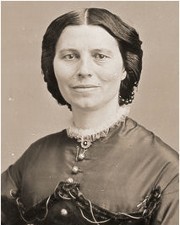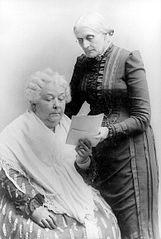In honor of Women’s History Month, today’s post shares stories of a handful of inspirational women with some lesser known facts and lessons learned – that inspire me. Hopefully they inspire you as well.
Clara Barton
The Lesson: Sometimes women do the work and men reap the rewards (but we don’t have to accept it).
 When we think of Clara Barton, we think of the “angel of the civil war”, who tended to the sick no matter what side they fought on, and then went on to found the Red Cross. But her first love was teaching. She got an early start, beginning to teach at the young age of 16. Not knowing any better as a beginning teacher, she refused to physically punish her students. The results were, none the less, outstanding. Reflecting upon this later, she wrote: “Child that I was, I did not know that the surest test of discipline is its absence.”
When we think of Clara Barton, we think of the “angel of the civil war”, who tended to the sick no matter what side they fought on, and then went on to found the Red Cross. But her first love was teaching. She got an early start, beginning to teach at the young age of 16. Not knowing any better as a beginning teacher, she refused to physically punish her students. The results were, none the less, outstanding. Reflecting upon this later, she wrote: “Child that I was, I did not know that the surest test of discipline is its absence.”
In 1851, after 16 years of success in teaching, Clara moved to Bordentown, NJ, where she opened her own school, in a place that had no free public schools. She was not paid and only wanted the opportunity. She said to those in the community: “If you will let me try, I will teach the children free for six months.”
The start was feeble – with only 6 students enrolled on day one. But her ability to teach and motivate soon changed that and over 200 pupils were attending within the year. With her success, the community rallied around the idea of the school and spent $4,000 to build a new school. The sum is astronomical – in today’s dollars that would equate to more than $121,000. This nice sum not only bought a new building, but a new principle. And it was not Clara. Instead it was a man, hired at twice her salary, to lead the successful school she founded, nurtured, and grew. Clara resigned with these words:
“I may sometimes be willing to teach for nothing, but if paid at all, I shall never do a man’s work for less than a man’s pay.”
Elizabeth Cady Stanton
The Lesson: Strong women benefit from strong women supporting them.
 Susan B. Anthony is the person most people associate with the women’s suffrage movement in the 1920s, yet Elizabeth Cady Stanton played a major role, both in the success of the movement and in Susan’s effectiveness.
Susan B. Anthony is the person most people associate with the women’s suffrage movement in the 1920s, yet Elizabeth Cady Stanton played a major role, both in the success of the movement and in Susan’s effectiveness.
Elizabeth was born in 1815. Elizabeth’s father, a lawyer, made it very clear that he wanted a son, and not a daughter. That is perhaps what drove her to excel in academics and to make her mark as supporting women’s rights.
Elizabeth was an eloquent writer. As co-organizer of the Seneca Falls Convention in the summer of 1848, it was she who wrote the “Declaration of Sentiments”. Throughout her lifetime, she wrote and spoke out, first about abolishing slavery, and then women’s rights, including the right to vote and to divorce.
She and Susan B. Anthony worked together tirelessly for women’s rights. Elizabeth was a mentor, a speech writer, an adviser. However, given that Anthony was neither married nor tending children, and Elizabeth had a brood of seven, it was Susan B. that was the public “face”, crossing the country and speaking for the movement. It was often Elizabeth’s words that were delivered by Susan, as Elizabeth was back at home, tending her home and family.
Anna Howard Shaw, another suffragist, wrote a description of the relationship between Stanton and Anthony in The Story of a Pioneer:
“She [Miss Anthony] often said that Mrs. Stanton was the brains of the new association, while she herself was merely its hands and feet; but in truth the two women worked marvelously together, for Mrs. Stanton was a master of words and could write and speak to perfection of the things Susan B. Anthony saw and felt but could not herself express.”
As such, Susan B. Anthony got the credit, the coin, and is seen as the primary mover of the women’s movement in these years. Yet without Elizabeth, as speech writer, thought leader, guide and mentor, Susan would not have been able to do what she did.
Billie Jean King
The Lesson: Sometimes you have to take a BIG risk to make a point.
 What must it like to be “best in the world” at something? Billie Jean King certainly knows – as she was the best Women’s tennis play for an amazing 20 years – winning 20 Wimbledon titles in both singles and doubles. But she was more than that – she was a fighter. A women who fought, and won, the battle for equal prize money for men and women. As such, she was the first female athlete to earn over $100,000. By the end of her tennis career, she had amassed close to $2,000,000 in prize money.
What must it like to be “best in the world” at something? Billie Jean King certainly knows – as she was the best Women’s tennis play for an amazing 20 years – winning 20 Wimbledon titles in both singles and doubles. But she was more than that – she was a fighter. A women who fought, and won, the battle for equal prize money for men and women. As such, she was the first female athlete to earn over $100,000. By the end of her tennis career, she had amassed close to $2,000,000 in prize money.
What a risk it must have been, to take on Bobby Riggs’ challenge, a pompous 55 year old former Men’s champion, in front of the world in 1973. Bobby was quite vocal about the inferiority of women’s play – and I recall being transfixed as I watched, and cheered for Billie Jean as she stepped up to what was billed as the “Battle of the Sexes” and beat him 6-4. 6-3 and 6-3. The game did not need 5 sets – only three. Her words sum up the pressure:
“I thought it would set us back 50 years if I didn’t win that match. It would ruin the Women’s tour and affect all women’s self esteem.”
Now, Billie Jean uses her energy, intellect, and drive to make positive impacts well beyond the tennis court. She founded the Women’s Tennis Association (1973), the Women’s Sports Foundation (1974), Women’s Sports Magazine (1974) and co-founded GreenSlam, an environmental initiative for the sports industry (2007). She was an early, and is an ongoing, leader in the LGBT fight for recognition and rights. And even as this is written, Billie Jean was speaking out about the fact that women are often overlooked as coaches.
Who are your female role models? And what lessons have you learned from them?




